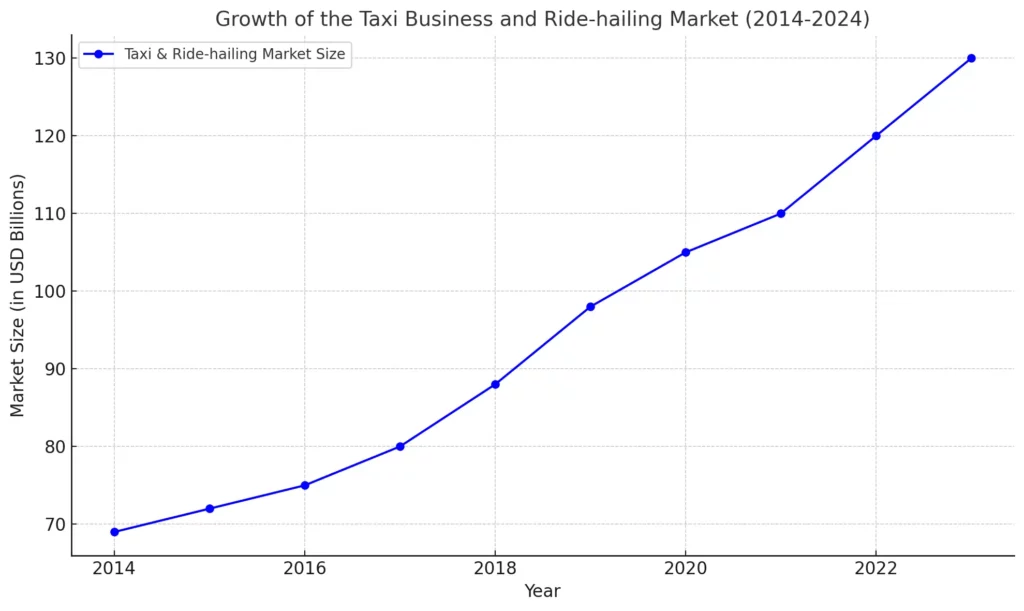Starting a taxi business can be a lucrative venture, especially with the rise of on-demand services and the convenience it offers to customers. Whether you’re looking to start a traditional taxi service or a ride-hailing app like Uber or Lyft, this guide will walk you through the essential steps, strategies, and tools you’ll need to succeed in 2024. Let’s dive into the complete guide on how to start a taxi business from scratch.
Why Start a Taxi Business?
With increasing urbanization and a growing preference for convenience, the demand for taxi services continues to rise globally. Customers are increasingly turning to ride-hailing apps and reliable taxi services to meet their transportation needs. Starting a taxi business in 2024 can tap into this expanding market, providing an opportunity to build a scalable, profitable business.
Market Trends for Taxi Business in
The taxi industry is evolving rapidly with the integration of technology and the rise of ride-hailing platforms. Check out the Report by IBIS. In 2024, there are several key trends shaping the future of the taxi business:
- Increased Adoption of Ride-Hailing Apps: Ride-hailing platforms like Uber, Lyft, and Didi have dominated the market. In 2024, traditional taxi companies are integrating similar booking apps to stay competitive.
- Sustainability and Electric Vehicles (EVs): With increasing concerns about climate change, many taxi companies are transitioning to electric or hybrid vehicles to reduce emissions and operating costs.
- Data-Driven Operations: Taxi businesses are using advanced analytics to optimize routes, track driver performance, and enhance customer experience. Data integration is critical for fleet management and dynamic pricing models.
- Autonomous Taxis: Though fully autonomous taxis are not widespread yet, several companies are testing self-driving vehicles, signaling a future shift toward driverless taxi services.
- On-Demand Services Expansion: Beyond passenger transport, taxi businesses are expanding into on-demand logistics, food delivery, and parcel services.

Different Types of Taxi Businesses

Starting a taxi business gives you several options depending on your target market, operational strategy, and business model. Here are the different types of taxi businesses you can consider:
- Traditional Taxi Service:
- Involves owning and managing a fleet of cars with licensed taxi drivers.
- Typically serves specific geographic regions with metered fare systems.
- Examples: Local taxi companies in major cities.
- Ride-Hailing App Service (Uber-like):
- A technology-driven model where customers book rides through a mobile app.
- Drivers can use their own vehicles, and the app facilitates payments, tracking, and ride assignment.
- Examples: Uber, Lyft, Grab.
- Luxury Taxi Service:
- Provides premium transportation services with luxury vehicles such as sedans or SUVs.
- Targets high-end customers, offering perks like private drivers, refreshments, and concierge-like services.
- Examples: Blacklane, Executive Limousines.
- Taxi Aggregator Model:
- An app-based service that aggregates multiple local taxi operators under one platform.
- Works as an intermediary, offering drivers from various companies to customers via a unified app.
- Examples: Ola, Careem.
- Airport Transfer Service:
- Specializes in providing transportation to and from airports.
- Typically works with hotels, travel agents, or directly with customers for pre-booked rides.

Steps to Start a Taxi Business
Step 1: Research the Taxi Industry
Before jumping into the taxi business, it is essential to conduct thorough research to understand the current market dynamics, local regulations, and customer preferences.
Key Market Insights:
- Understand the Market Demand: Look into how much demand exists in your target location. Use tools like Google Trends and local business reports to gauge potential growth.
- Competitive Landscape: Identify existing competitors, their pricing models, customer feedback, and the type of services they offer (ride-sharing, luxury, etc.).
- Regulatory Compliance: The taxi industry is heavily regulated. Ensure you are aware of the required licenses, permits, and insurance needed in your region. Cities often have specific taxi licensing systems, so check with local transportation authorities.
Step 2: Choose Your Taxi Business Model
When starting a taxi business in 2024, you have a variety of business models to choose from. Your choice will determine your operations, the level of investment required, and your customer base.
Types of Taxi Business Models:
- Traditional Taxi Service: This model involves owning a fleet of cars, hiring drivers, and providing point-to-point transportation services.
- Ride-Hailing App (Uber-like): Develop a taxi booking app where customers can book rides via a mobile application. This model often involves independent drivers who use their own vehicles.
- Luxury Taxi Service: Cater to a premium clientele by offering high-end vehicles and exclusive services.
- Taxi Aggregator: Partner with local taxi companies to aggregate services on a single platform, similar to how apps like Uber or Lyft operate.
Step 3: Create a Business Plan
Your business plan will act as a roadmap, guiding you through the startup phase and scaling process.
Essential Components of a Taxi Business Plan:
- Executive Summary: Briefly outline your business, vision, and objectives.
- Market Analysis: Include data on market size, target audience, and competition.
- Services Offered: Detail the type of taxi services you plan to offer (standard, luxury, app-based, etc.).
- Financial Plan: Estimate startup costs, operating expenses, and projected revenue.
- Marketing Strategy: Describe how you plan to acquire customers through both online (SEO, social media) and offline methods (local advertising, partnerships).
- Technology: Specify if you will develop an app for taxi bookings, use GPS tracking systems, or integrate other technologies for a better customer experience.
Step 4: Acquire Licenses and Insurance
Starting a taxi business requires compliance with various local, state, or federal regulations, depending on your location. Obtaining the necessary licenses and insurance is crucial to operating legally.
Important Licenses and Permits:
- Taxi Operator’s License: Typically issued by local transportation authorities.
- Vehicle Licenses: Every car in your fleet will need to be registered as a taxi.
- Insurance: Purchase commercial taxi insurance to cover liabilities, accidents, and injuries.
Step 5: Invest in Technology
In 2024, taxi businesses cannot thrive without robust technological support. Whether you’re running a traditional taxi service or an app-based ride-hailing service, technology will play a vital role.
Must-Have Technology for Taxi Businesses:
- Taxi Dispatch Software: This allows you to assign rides efficiently to drivers, monitor their performance, and track vehicles in real-time.
- GPS Navigation: Ensure all cars in your fleet have advanced GPS systems for accurate and fast routes.
- Mobile App: If you’re building a ride-hailing service, investing in a user-friendly app is critical. Features like in-app payments, ratings, ride history, and real-time tracking will enhance customer experience.
- Fleet Management Software: This will help you keep track of vehicle maintenance, fuel usage, and driver performance.
Step 6: Hire Qualified Drivers
The success of your taxi business largely depends on the quality of drivers you hire. Ensure that your drivers are reliable, courteous, and skilled at handling passengers.
How to Find and Hire Taxi Drivers:
- Background Checks: Perform thorough background checks to ensure the safety of your customers.
- Driver Training: Offer training in customer service, navigation, and the use of your dispatch or booking app.
- Incentive Programs: Consider offering competitive pay and performance-based incentives to attract and retain top drivers.
Step 7: Marketing Your Taxi Business
Marketing is key to attracting new customers and growing your taxi business in a competitive market. Implement both digital and traditional marketing strategies to reach a broad audience.
Effective Marketing Strategies:
- Search Engine Optimization (SEO): Ensure your website is optimized for local searches, like “taxi service near me” or “best taxi service in [City].”
- Social Media Marketing: Use platforms like Facebook and Instagram to promote your services, special offers, and discounts.
- Local Partnerships: Collaborate with hotels, restaurants, and event organizers to offer taxi services to their customers.
- Referral Programs: Encourage your customers to refer friends and family by offering discounts or rewards.
Cost of Starting a Taxi Business
The cost to start and develop a taxi business varies based on factors such as the business model, location, and technology used. Here’s a breakdown of the key cost components:
| Expense Category | Traditional Taxi Services (USD) | Ride-Hailing Platform (USD) | Description |
|---|---|---|---|
| Vehicle Purchase/Leasing | $30,000 – $100,000+ | N/A | Fleet cost for traditional taxi businesses (not applicable for ride-hailing) |
| App Development | $5,000 – $10,000 | $30,000 – $60,000 | Ride-hailing platform requires advanced app with GPS tracking, payment systems |
| Licenses and Permits | $5,000 – $15,000 | $3,000 – $10,000 | Includes medallions for traditional taxis or driver licenses for ride-hailing |
| Insurance | $10,000 – $30,000+ | $5,000 – $10,000 | Commercial insurance for both types, covering liabilities, accidents, etc. |
| Driver Recruitment & Training | $2,000 – $10,000 | $1,000 – $5,000 | Recruitment and onboarding for drivers; training in app usage for ride-hailing |
| Marketing & Promotion | $5,000 – $20,000+ | $10,000 – $30,000+ | Digital marketing, customer acquisition, brand building |
| Ongoing Maintenance & Fuel | $5,000 – $20,000 annually | N/A | For traditional taxis, regular vehicle maintenance costs (not applicable to ride-hailing) |
| Technology Maintenance | $2,000 – $5,000 per year | $5,000 – $15,000 per year | Regular updates for app, server hosting, and user support for ride-hailing |
Total estimated cost for starting a taxi business can range from $70,000 to $250,000, depending on your specific business model and the scope of your operations.
Cost Calculator for Taxi Business
Taxi Business Cost Calculator
Steps to Develop a Taxi App
Developing a taxi app requires a structured approach, involving several stages to ensure the app meets customer needs, offers a seamless experience, and stands out in the competitive market.
1. Market Research & Requirement Gathering
- Analyze Competitors: Study existing taxi apps (e.g., Uber, Lyft) to identify their strengths, weaknesses, and unique features.
- Identify Target Audience: Determine the demographics, preferences, and behaviors of your potential customers.
- Define Core Features: Based on your research, outline the essential features for drivers and riders, such as booking, fare calculation, payment options, and ride tracking.
2. Design the App Interface (UI/UX)
- Wireframing: Create simple wireframes to visualize the user interface, focusing on ease of use and intuitive navigation.
- UI/UX Design: Design the app to be visually appealing and easy to use. Key focus areas include a simple booking process, driver information, and real-time ride tracking.
3. Develop the App Backend
- Choose a Technology Stack: Select technologies such as Node.js or Python for the backend, React Native or Flutter for mobile development, and MongoDB or MySQL for the database.
- Build APIs: Develop APIs to enable communication between the app, server, and third-party services (like payment gateways, GPS tracking).
- Database Design: Set up the database to manage user data, ride history, and payments securely.
4. Develop the App for Users and Drivers
- Passenger App: This includes ride booking, real-time tracking, fare calculation, in-app chat, and payment gateways.
- Driver App: This includes accepting/rejecting ride requests, navigation integration, earnings reports, and ratings from passengers.
5. Implement Core Features
- Real-time GPS Tracking: Integrate GPS for real-time tracking of drivers and riders.
- Payment Gateway Integration: Integrate multiple payment options like credit cards, mobile wallets, and cash payments.
- Push Notifications: Notify riders and drivers about ride status, cancellations, payments, and promotions.
- In-App Chat: Allow passengers and drivers to communicate securely within the app.
6. Testing
- QA Testing: Test the app for bugs, performance issues, and usability. Ensure that all core features function smoothly across different devices and operating systems.
- Beta Testing: Release the app to a small group of users to collect feedback and improve performance.
7. Launch and Maintenance
- Launch on App Stores: Publish the app on Google Play and the Apple App Store.
- Post-launch Maintenance: Regularly update the app to fix bugs, add new features, and improve security.
Cost of Taxi App Development
The cost to develop a taxi app depends on various factors, such as app complexity, number of features, and the development team’s location. Here’s a typical cost breakdown:
| Development Component | Estimated Cost (USD) | Description |
|---|---|---|
| App Design (UI/UX) | $3,000 – $7,000 | Includes wireframing, design prototyping, and UI/UX design for both driver and passenger apps. |
| Backend Development | $5,000 – $10,000 | Backend setup, API development, and database integration. |
| Passenger App Development | $8,000 – $15,000 | Developing the core features such as booking, payments, and GPS tracking for the passenger app. |
| Driver App Development | $7,000 – $12,000 | Developing core features such as ride requests, earnings tracking, and navigation for the driver app. |
| Admin Panel Development | $4,000 – $8,000 | Admin dashboard for managing drivers, users, and rides. |
| Testing and QA | $3,000 – $5,000 | Functional testing, usability testing, and bug fixing. |
| Third-party Integrations (GPS, Payment Gateways, etc.) | $2,000 – $4,000 | Integration of payment systems, real-time tracking, and third-party services. |
| Maintenance and Updates | $1,000 – $3,000 per month | Regular updates, feature enhancements, and post-launch support. |
Total Development Cost: $30,000 – $60,000+ depending on app complexity and customizations.
Challenges of Starting a Taxi Business
Starting and managing a taxi business comes with its fair share of challenges. Being aware of these issues upfront allows you to mitigate risks and plan effectively.
- Regulatory Compliance:
- Taxi businesses are heavily regulated. You need to secure licenses, permits, and insurance, which can vary significantly from one location to another.
- Staying compliant with changing regulations, such as safety and emissions standards, can also be challenging.
- Competition from Ride-Hailing Apps:
- The rise of app-based ride-hailing services like Uber and Lyft poses a significant challenge for traditional taxi businesses.
- Competing with these companies requires adopting technology or offering specialized services.
- Driver Recruitment and Retention:
- Finding qualified, reliable drivers who meet safety and customer service standards can be tough.
- Retaining drivers can also be challenging due to high turnover rates in the industry.
- High Initial Capital:
- Purchasing or leasing a fleet of vehicles and developing the necessary technology (dispatch systems, apps) can be capital-intensive.
- Operational costs such as vehicle maintenance, insurance, and fuel can add up quickly.
- Technological Integration:
- Taxi businesses must adopt and continually upgrade their technology to remain competitive.
- Ensuring seamless GPS tracking, real-time ride management, and smooth payment processing can require ongoing investments.
Revenue Model for a Taxi Business
Your taxi business can generate revenue through several different streams. Here are the most common revenue models:
- Fare-based Revenue:
- Standard Taxi Fares: Charge customers per mile or per minute, with additional fees for waiting times or peak hours.
- Dynamic Pricing: Implement a surge pricing model during high-demand periods, similar to Uber or Lyft. This allows you to charge higher rates when demand exceeds the number of available drivers.
- Subscription or Membership Model:
- Offer frequent riders a monthly or annual subscription that provides benefits like discounted rides or priority service during peak times.
- Advertising Revenue:
- In-Car Advertising: Generate additional revenue by displaying ads inside the vehicle via tablets or video screens.
- App Advertising: Integrate advertising in your ride-hailing app where businesses can promote their services to users.
- Partnerships and Affiliates:
- Partner with local businesses like hotels, restaurants, or event venues to provide exclusive transportation services. This can lead to direct contracts or special rates that bring in regular business.
- Corporate Accounts:
- Offer transportation services to corporate clients. Companies can set up accounts for employee transportation, and you’ll get consistent revenue by providing rides for business purposes.
- On-demand Delivery Services:
- In addition to passenger transport, consider expanding into delivery services for food, parcels, or groceries. This can diversify your revenue streams and help you cater to a broader customer base.
- Driver Commissions:
- If you operate a ride-hailing service with independent drivers, you can earn revenue by taking a percentage commission from each ride completed by your drivers. Typically, platforms take around 15-30% of the fare as commission.
With the right blend of these revenue models, your taxi business can generate substantial and recurring revenue, ensuring profitability and scalability.
Possible Market Penetration Strategies
To succeed in the highly competitive taxi market, you’ll need to adopt effective strategies for market penetration. Here are some approaches to help your taxi business stand out:
- Leverage Technology:
- Develop a user-friendly, feature-rich mobile app to streamline ride bookings, payments, and real-time tracking.
- Offer in-app promotions and referral discounts to encourage first-time users and boost app downloads.
- Focus on Niche Markets:
- Target specific customer segments that are underserved by larger ride-hailing platforms, such as seniors, people with disabilities, or airport transfer customers.
- Offer tailored services like wheelchair-accessible vehicles or child-friendly rides.
- Partner with Local Businesses:
- Form partnerships with hotels, event venues, restaurants, and travel agencies to provide exclusive taxi services for their guests or customers.
- Build corporate accounts with companies that require regular transportation for employees.
- Offer Incentives for Drivers and Customers:
- Provide attractive incentives to both drivers and passengers. For example, offer bonuses to drivers for completing a certain number of rides and discounts to passengers for frequent use.
- Use loyalty programs, such as earning points per ride, to increase customer retention.
- Effective Local Marketing:
- Use localized SEO strategies to target customers searching for taxis in your service area.
- Advertise through local newspapers, radio, and social media platforms. You can also offer discounted or free rides during local events to gain visibility.
Best Locations to Start a Taxi Business
Choosing the right location is critical to the success of any taxi business. Whether you’re starting a traditional taxi service or a ride-hailing app, factors such as local demand, regulations, and competition will influence how successful your business can be. certain cities and regions present greater opportunities due to rising population density, tourism, and gaps in current transportation options.
Here are some of the best cities and countries to start a taxi business , based on these factors:
1. New York City, USA
- Demand: New York is one of the busiest cities in the world, with a large population and millions of tourists visiting each year. With over 8 million residents and a high demand for both traditional taxi services and ride-hailing platforms, it remains one of the top cities to consider.
- Regulations: New York City has strict taxi regulations, including the requirement of taxi medallions for traditional cabs. However, the ride-hailing market is still thriving despite these restrictions, as apps like Uber and Lyft continue to dominate the scene.
- Competition: While the competition is fierce, the demand for transportation in areas like Manhattan, Brooklyn, and Queens makes New York a lucrative market for both traditional taxi services and ride-hailing apps.
- Location-based Keywords: Starting a taxi business in New York, ride-hailing business in New York City.
2. London, UK
- Demand: London is another high-demand city for taxi services, with a dense population and a strong tourism industry. Londoners are used to using black cabs and ride-hailing services, offering a diverse customer base.
- Regulations: The UK has stringent licensing requirements for taxi drivers and vehicles, but ride-hailing platforms are well-established. The regulatory environment is favorable for new players if compliance is properly managed.
- Competition: With established brands like Uber and traditional black cabs, the competition is high. However, there is room for growth, especially in underserved areas of Greater London and for niche services like luxury or eco-friendly taxis.
- Location-based Keywords: Best cities for ride-hailing apps in 2024, taxi business in London.
3. Dubai, UAE
- Demand: Dubai’s rapidly growing population and tourism sector make it an excellent location for a taxi business. With millions of visitors arriving each year, transportation services are in high demand, especially for airport transfers and luxury rides.
- Regulations: The city has clear but strict guidelines for taxi and ride-hailing services, with both traditional taxis and ride-hailing services like Careem and Uber operating under government regulations.
- Competition: While the market is competitive, there are opportunities in offering specialized services, such as luxury or business-class rides, to cater to high-net-worth individuals and tourists.
- Location-based Keywords: Taxi business in Dubai, starting a taxi business in UAE.
4. Bangalore, India
- Demand: As one of India’s most populous and fastest-growing cities, Bangalore has an increasing need for both traditional taxi services and ride-hailing platforms. With a burgeoning tech industry and a rising middle class, the city presents a prime opportunity for transportation businesses.
- Regulations: India’s taxi market is less regulated than in the West, allowing for easier entry into the market. However, some local regulations, such as state licensing and emissions standards, still apply.
- Competition: Ride-hailing giants like Ola and Uber are already established, but there’s room for new players, especially in niche markets such as eco-friendly or female-driven taxis.
- Location-based Keywords: Starting a taxi business in India, ride-hailing business in Bangalore.
5. Cape Town, South Africa
- Demand: Cape Town’s vibrant tourism sector and large population create a strong demand for taxi services. The city is also becoming a hub for startups and expatriates, increasing the need for reliable transportation.
- Regulations: South Africa has a mix of formal and informal taxi services, but ride-hailing apps are growing in popularity. Regulations are in place for formal taxi services, but the barriers to entry are manageable for both ride-hailing platforms and traditional taxis.
- Competition: The competition includes both local taxi services and international ride-hailing companies like Bolt. However, there is still significant opportunity for growth, particularly for app-based services.
- Location-based Keywords: Taxi business in Cape Town, best cities for ride-hailing apps in 2024.
6. Singapore
- Demand: Singapore’s well-developed public transport system is complemented by a high demand for taxis and ride-hailing services, especially among business professionals and tourists. The city’s dense population makes it ideal for a taxi business that focuses on luxury or eco-friendly vehicles.
- Regulations: Singapore has stringent regulations for taxi businesses, including licensing for drivers and vehicles. However, the government has created a business-friendly environment, making it easier for new entrants to comply with regulations.
- Competition: The market is competitive, with companies like Grab dominating, but niche services such as luxury taxis or green taxis can carve out a strong presence.
- Location-based Keywords: Starting a taxi business in Singapore, ride-hailing app in Singapore.
| City/Region | Demand | Regulations | Competition | Opportunities |
|---|---|---|---|---|
| New York, USA | Very High (8M+ residents, tourists) | Strict (medallions required for taxis) | High (Uber, Lyft, yellow cabs) | High demand for both taxi and ride-hailing |
| London, UK | High (Residents and tourists) | Strict licensing for drivers and vehicles | High (Uber, black cabs) | Niche services like luxury and eco-friendly taxis |
| Dubai, UAE | High (Growing tourism industry) | Strict but clear guidelines | Moderate (Careem, Uber) | Luxury and airport transfer services |
| Bangalore, India | High (Tech hub, growing middle class) | Moderate regulations on taxis | Moderate to High (Uber, Ola) | Budget-friendly or eco-friendly options |
| Cape Town, South Africa | High (Tourists and locals) | Mixed regulations for formal/informal taxis | Moderate (Bolt, local taxis) | App-based ride-hailing services |
| Singapore | High (Business professionals, tourists) | Strict (Vehicle licensing and driver requirements) | High (Grab, taxis) | Luxury and eco-friendly niches |
How to Choose the Best Location for Your Taxi Business

When selecting a location to start your taxi business in 2024, consider the following factors:
- Demand: Cities with high population density, significant tourism, and limited public transport options are more likely to require taxi services.
- Regulations: Research the regulatory requirements in your chosen location, including licensing, vehicle standards, and operational permits.
- Competition: Evaluate existing competitors, both traditional and ride-hailing platforms. Look for gaps in the market or underserved customer segments to penetrate.
- Economic Conditions: Choose a city or region where disposable income is rising, allowing consumers to afford taxi services and ride-hailing platforms.
- Technological Penetration: Ensure that the location has a strong mobile app adoption rate, as this will be critical for the success of ride-hailing platforms.
By evaluating these factors, you can identify the best cities to start a taxi business in 2024 and position your company for success. Whether you’re targeting major cities like New York and London or emerging markets like Bangalore and Cape Town, the right location can significantly enhance your chances of success in the competitive transportation industry.
Mistakes to Avoid When Starting a Taxi Business
While starting a taxi business can be lucrative, there are some common mistakes that can hinder your success. Here are key pitfalls to avoid:
- Underestimating Regulatory Requirements:
- Many entrepreneurs overlook the complexity of local regulations and fail to secure the necessary permits and licenses. This can lead to fines, shutdowns, or delayed operations.
- Ensure you fully understand all legal requirements for both drivers and vehicles in your jurisdiction before launching.
- Poor Technology Implementation:
- Failing to invest in a good-quality mobile app or dispatch system can alienate customers and drivers.
- If the app is slow, buggy, or lacks essential features like real-time tracking and seamless payments, users will quickly turn to competitors.
- Neglecting Customer Service:
- In a service-based business, customer satisfaction is critical. Poor communication, late pickups, and driver issues can damage your reputation.
- Always prioritize fast response times, courteous drivers, and transparent communication to build long-term relationships with customers.
- Ignoring Driver Well-Being:
- Many businesses fail to consider the needs and satisfaction of their drivers. Burnout, low pay, and lack of support can result in high driver turnover.
- Offer competitive pay, flexible schedules, and incentives to retain quality drivers.
- Lack of a Marketing Strategy:
- Relying solely on word of mouth or not having a defined marketing plan can slow down your growth.
- Invest in digital marketing strategies, including social media, SEO, and partnerships, to increase your brand visibility and attract more customers.
Miracuves Offers Ready-Made Taxi App for $1899
At Miracuves Solutions, we understand the need for fast, reliable, and cost-effective solutions. That’s why we offer a ready-made taxi app starting at just $1899. Our pre-built app is designed to get you up and running quickly, without the hassle of building everything from scratch. It’s ideal for startups and businesses looking to launch a taxi service with minimal upfront costs.
Here’s a breakdown of what’s included in our Ready-Made Taxi App Package:
| Feature | Included in the $1899 Package | Description |
|---|---|---|
| Passenger App | Yes | – Easy-to-use interface for booking rides, fare calculation, and payments. – Real-time GPS tracking for users to track their ride. |
| Driver App | Yes | – Accept/reject ride requests, track earnings, and access navigation. – Real-time trip management and route optimization. |
| Admin Panel | Yes | – Web-based admin dashboard for managing drivers, passengers, and rides. – View trip history, earnings reports, and monitor app activity. |
| Payment Integration | Yes | – Support for credit card and in-app wallet payments. – Secure payment gateway integration. |
| Real-Time GPS Tracking | Yes | – Track rides in real-time for both drivers and passengers. |
| Push Notifications | Yes | – Alerts for ride confirmations, cancellations, and promotions. |
| In-App Chat | Yes | – Enable secure communication between drivers and passengers. |
| Multi-Language Support | Yes | – Support for multiple languages to cater to different regions. |
| White-Label Branding | Yes | – Customize the app with your branding (logo, color scheme, etc.). |
| Basic Customizations | Yes | – Adjust the app to meet your specific business requirements. |
| Free Installation & Setup | Yes | – Full setup and deployment on your server or app stores. |
| 3-Month Technical Support | Yes | – Get assistance with any technical issues during the first 3 months of operation. |
Why Choose Miracuves’ Ready-Made Taxi App?
- Quick Launch: With our ready-made solution, you can launch your taxi business in a matter of days.
- Cost-Effective: Starting at just $1899, you get all the essential features of a taxi app without the high costs of custom development.
- Scalable: As your business grows, you can easily add more features or scale your operations with our flexible app.
- Proven Solution: Our ready-made app is tried and tested, ensuring a seamless experience for both drivers and passengers.
Contact Miracuves Solutions today to get your ready-made taxi app and start your business with confidence!
Conclusion: Start Your Taxi Business
Starting a taxi business in 2024 is a profitable venture, especially with the increasing demand for convenient, on-demand transportation. By following the steps outlined in this guide—researching the market, choosing the right business model, investing in technology, hiring qualified drivers, and implementing effective marketing strategies—you can set your business up for success.
If you’re looking to streamline the process and develop a taxi app or taxi dispatch software, Miracuves Solutions is here to help. With our expertise in mobile app development and fleet management solutions, we can turn your taxi business idea into a thriving enterprise. Contact us today to discuss your project.
FAQ
What Are the Best Cities to Start a Taxi Business ?
The best cities to start a taxi business in 2024 are typically large urban centers with high demand for transportation services, such as New York, London, Dubai, and Bangalore. These cities offer large customer bases, though each has its own set of regulations and competition. Choosing the right city depends on factors like demand, local regulations, and existing competitors.
How Much Does It Cost to Start a Taxi Business?
The cost to start a taxi business varies depending on the model you choose. For traditional taxi services, expenses include vehicle acquisition, licensing, and insurance, with initial costs ranging from $70,000 to $150,000. For a ride-hailing platform, the primary investment is in app development and marketing, with initial costs between $30,000 and $60,000.
How Do I Grow a Taxi Business ?
Growing a taxi business in 2024 requires a blend of technology integration, customer-centric services, and effective marketing strategies. For traditional taxi services, expanding your fleet and integrating app-based bookings can improve customer convenience. For ride-hailing platforms, offering incentives, surge pricing during high demand, and partnering with corporate clients can boost your market reach.
What’s the Difference Between Traditional Taxi Services and Ride-Hailing Platforms?
Traditional taxi services rely on company-owned fleets and typically use metered fares regulated by local authorities. Ride-hailing platforms like Uber and Lyft, on the other hand, use driver-owned vehicles, and fares are determined by dynamic pricing based on demand. Ride-hailing platforms are more scalable due to lower operational costs and better technology integration.
What Is the Revenue Model for a Ride-Hailing App?
The revenue model for a ride-hailing app includes multiple streams: commission on fares (typically 15-30%), dynamic pricing during peak hours, and additional services such as in-app advertising and subscription-based memberships. Ride-hailing platforms can also diversify into services like food and parcel delivery, providing more revenue opportunities.
What Are the Key Challenges in Starting a Taxi Business?
The key challenges in starting a taxi business include high initial investment, especially for vehicle acquisition and licensing in traditional taxi services. In ride-hailing platforms, competition from established players like Uber and Lyft can be tough. Other challenges include driver recruitment, ensuring regulatory compliance, and staying updated with technology trends to meet customer expectations.






